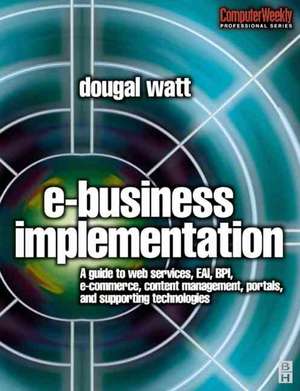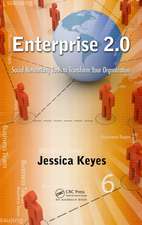E-business Implementation:
Autor Dougal Watten Limba Engleză Hardback – 14 aug 2002
E-business provides a powerful mechanism for organizations to increase productivity and lower costs. However, in order to utilise these considerable benefits, companies must ensure their e-business is implemented correctly and is appropriate to their market segment.
'E-business Implementation' provides a comprehensive guide to successful implementation and is divided into three parts:
* Part one begins with a project management structure designed to deliver successful e-business functionality within time and budget, while avoiding the high failure rates common to many technology projects.
* Part two details key concepts, technologies, products, vendors, benefits, limitations, and high-level design architectures for e-business, in a phased and risk-managed approach. These include publishing through the Internet and Intranets, portals and content management systems, transacting using e-commerce, integrating internal enterprise applications, integrating with external partners and suppliers, and responding in real-time to changing levels of demand through dynamic e-business and web services.
* Part three details a set of critical foundation technologies that must be implemented correctly for the e-business initiative to be successful. These technologies include e-business development languages such as Java, XML and .Net, hardware platforms and their operating systems, security and networking systems, the Internet Domain Name System, and Open Source technologies.
Preț: 379.84 lei
Preț vechi: 654.19 lei
-42% Nou
Puncte Express: 570
Preț estimativ în valută:
72.69€ • 75.43$ • 60.76£
72.69€ • 75.43$ • 60.76£
Carte tipărită la comandă
Livrare economică 10-24 martie
Preluare comenzi: 021 569.72.76
Specificații
ISBN-13: 9780750657518
ISBN-10: 0750657510
Pagini: 346
Ilustrații: Approx. 100 illustrations
Dimensiuni: 174 x 246 x 24 mm
Greutate: 0.8 kg
Ediția:1
Editura: Taylor & Francis
Colecția Routledge
Locul publicării:Oxford, United Kingdom
ISBN-10: 0750657510
Pagini: 346
Ilustrații: Approx. 100 illustrations
Dimensiuni: 174 x 246 x 24 mm
Greutate: 0.8 kg
Ediția:1
Editura: Taylor & Francis
Colecția Routledge
Locul publicării:Oxford, United Kingdom
Public țintă
Professional Practice & DevelopmentCuprins
Structuring an e-business project; Resourcing an e-business project; The five phases of e-business adoption; Phase 1: Internet-based e-business publishing; Phase 2: transacting with customers; Phase 3: internal enterprise application integration; Phase 4: external integration; Phase 5: dynamic e-business and web services; Critical technologies supporting e-business; Java, XML, .Net; Hardware platforms and operating systems; Security; Networking systems; DNS; Open Source technologies; References; Index.
Descriere
'E-business Implementation' is written as a complete guide to successful e-business delivery, from both a project management and a detailed technological perspective.
E-business provides a powerful mechanism for organizations to increase productivity and lower costs. However, in order to utilise these considerable benefits, companies must ensure their e-business is implemented correctly and is appropriate to their market segment.
'E-business Implementation' provides a comprehensive guide to successful implementation and is divided into three parts:
* Part one begins with a project management structure designed to deliver successful e-business functionality within time and budget, while avoiding the high failure rates common to many technology projects.
* Part two details key concepts, technologies, products, vendors, benefits, limitations, and high-level design architectures for e-business, in a phased and risk-managed approach. These include publishing through the Internet and Intranets, portals and content management systems, transacting using e-commerce, integrating internal enterprise applications, integrating with external partners and suppliers, and responding in real-time to changing levels of demand through dynamic e-business and web services.
* Part three details a set of critical foundation technologies that must be implemented correctly for the e-business initiative to be successful. These technologies include e-business development languages such as Java, XML and .Net, hardware platforms and their operating systems, security and networking systems, the Internet Domain Name System, and Open Source technologies.
E-business provides a powerful mechanism for organizations to increase productivity and lower costs. However, in order to utilise these considerable benefits, companies must ensure their e-business is implemented correctly and is appropriate to their market segment.
'E-business Implementation' provides a comprehensive guide to successful implementation and is divided into three parts:
* Part one begins with a project management structure designed to deliver successful e-business functionality within time and budget, while avoiding the high failure rates common to many technology projects.
* Part two details key concepts, technologies, products, vendors, benefits, limitations, and high-level design architectures for e-business, in a phased and risk-managed approach. These include publishing through the Internet and Intranets, portals and content management systems, transacting using e-commerce, integrating internal enterprise applications, integrating with external partners and suppliers, and responding in real-time to changing levels of demand through dynamic e-business and web services.
* Part three details a set of critical foundation technologies that must be implemented correctly for the e-business initiative to be successful. These technologies include e-business development languages such as Java, XML and .Net, hardware platforms and their operating systems, security and networking systems, the Internet Domain Name System, and Open Source technologies.








